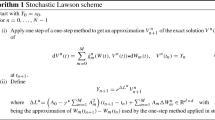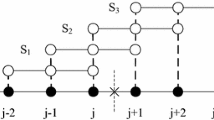Abstract
Perturbed Runge–Kutta methods (also referred to as downwind Runge–Kutta methods) can guarantee monotonicity preservation under larger step sizes relative to their traditional Runge–Kutta counterparts. In this paper we study the question of how to optimally perturb a given method in order to increase the radius of absolute monotonicity (a.m.). We prove that for methods with zero radius of a.m., it is always possible to give a perturbation with positive radius. We first study methods for linear problems and then methods for nonlinear problems. In each case, we prove upper bounds on the radius of a.m., and provide algorithms to compute optimal perturbations. We also provide optimal perturbations for many known methods.


Similar content being viewed by others
Notes
Although the results in [24] are given in the context of contractivity, they are also relevant to the preservation of monotonicity. In [24, Thm. 5.1], quotients \(m_\tau [x,y]\) and one-sided Gateaux variations (\(m_+[ x,y], m_-[ x,y]\)), are used for \(x=u-{{\tilde{u}}}\) and \(y=f(u)-f({\tilde{u}})\) to obtain the contractivity property \(\Vert u(t)-\tilde{u}(t)\Vert \le \Vert u(t_0)-{\tilde{u}}(t_0)\Vert \) for \(t\ge t_0\). In the context of monotonicity, we simply take \(x=u\) and \(y=f(u)\) to obtain the monotonicity property \(\Vert u(t)\Vert \le \Vert u(t_0)\Vert \) for \(t\ge t_0\).
References
Bogacki, P., Shampine, L.F.: An efficient Runge–Kutta (4, 5) pair. Comput. Math. Appl. 32(6), 15–28 (1996)
Calvo, M., Montijano, J.I., Rández, L.: A new embedded pair of Runge–Kutta formulas of orders 5 and 6. Comput. Math. Appl. 20(1), 15–24 (1990)
Conde, S., Gottlieb, S., Grant, Z.J., Shadid, J.N.: Implicit and implicit–explicit strong stability preserving Runge–Kutta methods with high linear order. J. Sci. Comput. 73(2), 667–690 (2017)
Donat, R., Higueras, I., Martínez-Gavara, A.: On stability issues for IMEX schemes applied to hyperbolic equations with stiff reaction terms. Math. Comput. 80, 2097–2126 (2011)
Dormand, J.R., Prince, P.J.: A family of embedded Runge–Kutta formulae. J. Comput. Appl. Math. 6(1), 19–26 (1980)
Fehlberg, E.: Klassische Runge–Kutta–Formeln fünfter und siebenter Ordnung mit Schrittweiten–Kontrolle. Computing 4(2), 93–106 (1969)
Ferracina, L., Spijker, M.N.: Stepsize restrictions for the total-variation-diminishing property in general Runge–Kutta methods. SIAM J. Numer. Anal. 42, 1073–1093 (2004)
Gottlieb, S., Ketcheson, D.I., Shu, C.W.: Strong Stability Preserving Runge–Kutta and Multistep Time Discretizations. World Scientific Publishing Company, Singapore (2011)
Gottlieb, S., Ruuth, S.J.: Optimal strong-stability-preserving time-stepping schemes with fast downwind spatial discretizations. J. Sci. Comput. 27, 289–303 (2006)
Gottlieb, S., Shu, C.W.: Total variation diminishing Runge–Kutta schemes. Math. Comput. 67(221), 73–85 (1998)
Hairer, E., Wanner, G.: Solving Ordinary Differential Equations II. Springer, Berlin (1991)
Heun, K.: Neue methoden zur approximativen integration der differentialgleichungen einer unabhängigen veränderlichen. Z. Math. Phys. 45, 23–38 (1900)
Higueras, I.: Representations of Runge–Kutta methods and strong stability preserving methods. SIAM J. Numer. Anal. 43, 924–948 (2005)
Higueras, I.: Strong stability for additive Runge–Kutta methods. SIAM J. Numer. Anal. 44(4), 1735–1758 (2006)
Higueras, I.: Positivity properties for the classical fourth order Runge–Kutta methods. Monografías de la Real Academia de Ciencias de Zaragoza 33, 125–139 (2010)
Higueras, I., Ketcheson, D.I.: Reproducibility repository for computations of optimal perturbations to Runge-Kutta methods, version 0.2 (2016). https://doi.org/10.5281/zenodo.1146916
Horváth, Z.: On the positivity step size threshold of Runge–Kutta methods. Appl. Numer. Math. 53, 341–356 (2005)
Hundsdorfer, W., Koren, B., van Loon, M., Verwer, J.C.: A positive finite-difference advection scheme. J. Comput. Phys. 117(1), 35–46 (1995)
Ketcheson, D.I.: Highly efficient strong stability preserving Runge–Kutta Methods with low-storage implementations. SIAM J. Sci. Comput. 30, 2113–2136 (2008)
Ketcheson, D.I.: Computation of optimal monotonicity preserving general linear methods. Math. Comput. 78, 1497–1513 (2009)
Ketcheson, D.I.: High Order Strong Stability Preserving Time Integrators and Numerical Wave Propagation Methods for Hyperbolic PDEs. Doctoral thesis, University of Washington (2009)
Ketcheson, D.I.: Step sizes for strong stability preservation with downwind-biased operators. SIAM J. Numer. Anal. 49(4), 1649–1660 (2011)
Ketcheson, D.I.: Nodepy software version 0.6.1 (2015). Available from http://github.com/ketch/nodepy
Kraaijevanger, J.F.B.M.: Contractivity of Runge–Kutta methods. BIT 31, 482–528 (1991)
LeVeque, R.J., Yee, H.C.: A study of numerical methods for hyperbolic conservation laws with stiff source terms. J. Comput. Phys. 210, 187–210 (1990)
Merson, R.H.: An operational method for the study of integration processes. In: Proceedings of the Symposium on Data Processing, pp. 1–25 (1957)
Prince, P.J., Dormand, J.R.: High order embedded Runge–Kutta formulae. J. Comput. Appl. Math. 7(1), 67–75 (1981)
Ruuth, S.J.: Global optimization of explicit strong-stability-preserving Runge–Kutta Methods. Math. Comput. 75, 183–207 (2006)
Ruuth, S.J., Spiteri, R.J.: High-order strong-stability-preserving Runge–Kutta methods with downwind-biased spatial discretizations. SIAM J. Numer. Anal. 42, 974–996 (2004)
Shu, C.W., Osher, S.: Efficient implementation of essentially non-oscillatory shock-capturing schemes. J. Comput. Phys. 77(2), 439–471 (1988)
Zhang, X., Shu, C.W.: On maximum-principle-satisfying high order schemes for scalar conservation laws. J. Comput. Phys. 229(9), 3091–3120 (2010)
Author information
Authors and Affiliations
Corresponding author
Additional information
The Inmaculada Higueras was supported by Ministerio de Economía y Competividad, Spain, Projects MTM2014-53178-P and MTM2016-77735-C3-2-P. The David I. Ketcheson and Tihamér A. Kocsis were supported by KAUST Award No. FIC/2010/05-2000000231. The Tihamér A. Kocsis was also supported by TÁMOP-4.2.2.A-11/1/KONV-2012-0012: Basic research for the development of hybrid and electric vehicles, supported by the Hungarian Government and co-financed by the European Social Fund.
Appendix
Appendix
In this section we give additional details on SSP coefficients and optimal perturbations of second order 2-stage Runge–Kutta methods and the classical 4-stage fourth order Runge–Kutta method.
1.1 Second Order 2-Stage Methods
We consider the family of 2-stage second order methods (26). In Example 1 we studied perturbations that increase the SSP coefficient for the linear case. For nonlinear problems, in Example 3, Fig. 2 shows the values of \(R^{\mathrm{opt}}(K)\) for \(\alpha \in [-3,3]\).
In this section, for each \(\alpha \), we give the expressions for \(R^{\mathrm{opt}}(K)\) and we show optimal perturbations \(\widetilde{K}_{NL}\) such that \(R(K, \widetilde{K}_{NL})=R^{\mathrm{opt}}(K)\). It is important to point out the convenience of choosing \(\widetilde{K}_{NL}= \widetilde{K}_{L}\), where \(\widetilde{K}_{L}\) denotes the optimal perturbation for the linear case. In this case, we have not only \(R(K, \widetilde{K}_{L})=R^{\mathrm{opt}}(K)\) but also \({R}_{\mathrm{Lin}}(K, \widetilde{K}_{NL})=R_{\mathrm{Lin}}^{\mathrm{opt}}(K)\). The computations required to obtain the results in this section have been done with the symbolic computation program Mathematica.
If we denote by \(r=R^{\mathrm{opt}}(K)\), we have that
Next we give optimal perturbations \(\widetilde{K}_{NL}\).
For \(\alpha <0\), we obtain that it is not possible to obtain a perturbation of the form (26) with \({\tilde{b}}_2=0\) and \({\tilde{a}}_{21}=0\). Consequently, \(\widetilde{K}_{NL}\ne \widetilde{K}_{L}\) and we always have that \({R}_{\mathrm{Lin}}(K, \widetilde{K}_{NL})<R_{\mathrm{Lin}}^{\mathrm{opt}}(K)\). Optimal perturbations of the form (26) for different values of \(\alpha <0\) must satisfy the following conditions.
-
For \(-\frac{1}{2} \left( 1+\sqrt{7}\right) \le \alpha <0\), the coefficients \({\tilde{a}}_{21}, {\tilde{b}}_1\) and \({\tilde{b}}_2\) in \(\widetilde{K}_{NL}\) must satisfy
$$\begin{aligned} -\,\alpha \le {\tilde{a}}_{21}\le \frac{1-r \, \alpha }{2 \, r}, \qquad {\tilde{b}}_1=-\frac{r\, {\tilde{a}}_{21}}{2\, \alpha } , \qquad {\tilde{b}}_2=-\frac{1}{2\, \alpha }, \end{aligned}$$where \(r=R^{\mathrm{opt}}(K)\).
-
For \(\alpha \le -\frac{1}{2} \left( 1+\sqrt{7}\right) \), we should have
$$\begin{aligned} {\tilde{a}}_{21}=-\,\alpha ,\qquad -\frac{1}{2 \,\alpha }\le {\tilde{b}}_1\le \frac{-2 \,\alpha ^2-2 \, \alpha +1}{4\, \alpha }, \qquad -\,\frac{1}{2 \,\alpha }\le {\tilde{b}}_2\le \frac{2\, \alpha \,{\tilde{b}}_1-1}{4\, \alpha }. \end{aligned}$$
For \(\alpha >0\) we can find optimal perturbations with \({\tilde{b}}_2=0\) and \({\tilde{a}}_{21}=0\). Coefficient \({\tilde{b}}_1\) must satisfy the following conditions.
-
For \(0<\alpha \le \left( -\,1+\sqrt{7}\right) /2\), we have that
$$\begin{aligned} \qquad {\tilde{b}}_1=\frac{\sqrt{3 \alpha ^2-2 \alpha +1}-\alpha }{2 \alpha } . \end{aligned}$$(73)Thus there is a unique \(\widetilde{K}_{NL}\) of the form (26). In this case, we have \(R(K)<R(K, \widetilde{K}_{NL})=R^{\mathrm{opt}}(K)\).
-
For \(\left( -1+\sqrt{7}\right) /2<\alpha < 1\), we also get \(R(K)<R^{\mathrm{opt}}(K)\), but in this case the optimal perturbation \(\widetilde{K}_{NL}\) is not unique. All the perturbations with \({\tilde{b}}_1\) satisfying
$$\begin{aligned} \frac{1-\alpha }{\alpha } \le {\tilde{b}}_1\le \frac{2 \alpha ^2-2 \alpha +1}{4 \alpha } , \end{aligned}$$are optimal. In particular, we can take \(\widetilde{K}_{NL}=\widetilde{K}_{L}\). With this choice, \(R(K, \widetilde{K}_{L})=R^{\mathrm{opt}}(K)=1/\alpha \) and \({R}_{\mathrm{Lin}}(K, \widetilde{K}_{L})=R_{\mathrm{Lin}}^{\mathrm{opt}}(K)\approx 1.22\). Furthermore, \(\alpha =\left( -\,1+\sqrt{7}\right) /2\) provides the largest SSP coefficient within the family of 2-stage second order method (see Fig. 2).
-
For \(1\le \alpha \), we have \(R(K)=R^{\mathrm{opt}}(K)=1/\alpha \) and the optimal perturbation \(\widetilde{K}_{NL}\) is not unique. All the values
$$\begin{aligned}0\le {\tilde{b}}_1\le \frac{2 \alpha ^2-2 \alpha +1}{4 \alpha } \end{aligned}$$give optimal perturbations. We can take \(\widetilde{K}_{NL}=0\), but in this case \({R}_{\mathrm{Lin}}(K, 0)< R_{\mathrm{Lin}}^{\mathrm{opt}}(K)\). A better choice is \(\widetilde{K}_{NL}=\widetilde{K}_{L}\). Observe that, for \(\alpha =1\), we get the optimal SSP coefficient \(R(K)=1\) that cannot be increased by perturbations.
Next, we consider some concrete values of \(\alpha \) to show the the expressions of the perturbations. For each value, we give the Butcher tableau of the perturbation and matrices \(\alpha ^{\mathrm{up}}\) and \(\alpha ^{\mathrm{down}}\) in (36).
-
For \(\alpha =1/2\) we get method RK2a in [18] with \(R(K)=0\). With perturbation
$$\begin{aligned} \widetilde{K}&= \begin{pmatrix} 0 &{}\quad 0 &{} \quad 0 \\ 0 &{}\quad 0 &{}\quad 0\\ {\tilde{b}}_1 &{}\quad 0 &{}\quad 0 \end{pmatrix}, \quad \alpha ^{\mathrm{up}}= \begin{pmatrix} 0 &{}\quad 0 &{}\quad 0 \\ {\tilde{b}}_1 &{}\quad 0 &{}\quad 0\\ 0 &{}\quad 2 {\tilde{b}}_1 &{}\quad 0 \end{pmatrix}, \quad \alpha ^{\mathrm{down}}= \begin{pmatrix} 0 &{} \quad 0 &{}\quad 0 \\ 0 &{}\quad 0 &{}\quad 0\\ 1-2{\tilde{b}}_1 &{}\quad 0 &{}\quad 0 \end{pmatrix},\nonumber \\ \gamma&= \begin{pmatrix} 1\\ 1-{\tilde{b}}_1\\ 0 \end{pmatrix}, \end{aligned}$$(74)where \({\tilde{b}}_1=\frac{1}{2} \left( \sqrt{3}-1\right) \), we get \(R(K,\widetilde{K}) ={R}_{\mathrm{Lin}}(K, \widetilde{K})= \sqrt{3}-1\).
-
For \(\alpha =2/3\), we have a nontrivial SSP coefficient \(R^{\mathrm{opt}}(K)=1/2\), but we can increase this value to \(R(K,\widetilde{K}_1)=R^{\mathrm{opt}}(K)=1\) with perturbation
$$\begin{aligned} \widetilde{K}_1&= \begin{pmatrix} 0 &{} \quad 0 &{}\quad 0 \\ 0 &{}\quad 0 &{}\quad 0\\ 1/4 &{}\quad 0 &{}\quad 0 \end{pmatrix}, \quad \alpha ^{\mathrm{up}}= \begin{pmatrix} 0 &{} \quad 0 &{}\quad 0 \\ 2/3 &{}\quad 0 &{}\quad 0\\ 0 &{}\quad 3/4 &{}\quad 0 \end{pmatrix} , \quad \alpha ^{\mathrm{down}}= \begin{pmatrix} 0 &{}\quad 0 &{}\quad 0 \\ 0 &{}\quad 0 &{}\quad 0\\ 1/4 &{}\quad 0 &{}\quad 0 \end{pmatrix} ,\\ \gamma&= \begin{pmatrix} 1\\ 1/3\\ 0 \end{pmatrix}. \end{aligned}$$For this perturbation, \(R(\phi _K)={R}_{\mathrm{Lin}}(K, \widetilde{K}_1)=1\). We can take \(\gamma =(1,0,0)^t\) by modifying the first column of \(\alpha ^{\mathrm{up}}\) and \(\alpha ^{\mathrm{down}}\) according to (50),
$$\begin{aligned} \widetilde{K}_2&= \begin{pmatrix} 0 &{}\quad 0 &{}\quad 0 \\ 1/6 &{}\quad 0 &{}\quad 0\\ 3/8 &{}\quad 0 &{}\quad 0 \end{pmatrix}, \quad \alpha ^{\mathrm{up}}= \begin{pmatrix} 0 &{} \quad 0 &{} \quad 0 \\ 5/6 &{} \quad 0 &{} \quad 0\\ 0 &{} \quad 3/4 &{} \quad 0 \end{pmatrix} , \quad \alpha ^{\mathrm{down}}= \begin{pmatrix} 0 &{} \quad 0 &{} \quad 0 \\ 1/6 &{} \quad 0 &{} \quad 0\\ 1/4 &{} \quad 0 &{} \quad 0 \end{pmatrix} ,\\ \gamma&= \begin{pmatrix} 1\\ 0\\ 0 \end{pmatrix}. \end{aligned}$$ -
As it has been pointed out above, the largest value in the \(\alpha \)-family of 2-stage second order schemes is \(R^{\mathrm{opt}}(K)=(1+\sqrt{7})/3\) and it is obtained for \(\alpha =(\sqrt{7}-1)/2\). The perturbation is of the form (26) with \({\tilde{b}}_1= \left( \sqrt{7}-2\right) /2\), and
$$\begin{aligned} \alpha ^{\mathrm{up}}= \begin{pmatrix} 0 &{} \quad 0 &{} \quad 0 \\ 1 &{} \quad 0 &{} \quad 0\\ 0 &{} \quad \frac{1}{9} \left( 4+\sqrt{7}\right) &{}\quad 0 \end{pmatrix} , \quad \alpha ^{\mathrm{down}}= \begin{pmatrix} 0 &{} \quad 0 &{} \quad 0 \\ 0 &{} \quad 0 &{} \quad 0\\ \frac{1}{9} \left( 5-\sqrt{7}\right) &{} \quad 0 &{} \quad 0 \end{pmatrix} , \quad \gamma _r = \begin{pmatrix} 1\\ 0 \\ 0 \end{pmatrix} \end{aligned}$$This is the perturbation obtained in [9, Table V] by numerical search in the class of perturbations considered in [9].
1.2 Classical Fourth Order 4-Stage Method
For nonlinear problems, applying the analysis above, we find that the optimal perturbation of the classical method has SSP coefficient given by the real root of \(x^3+2 x^2+4 x-4=0\), which is approximately \(R^{\mathrm{opt}}(K)\approx 0.685016\). The corresponding perturbation is not unique. For instance, we can take \(\gamma _r=(1,0,0,0,0)\), and all entries of \(\alpha ^{\mathrm{down}}_r\) equal to zero except
where \(r=R^{\mathrm{opt}}(K)\). However, there exist other optimal perturbations with additionally \((\alpha ^{\mathrm{down}}_r)_{42}=\epsilon \) where \(0\le \epsilon \le 0.782\).
We remark that nearly-optimal perturbations for this method are given in [30, p. 448] and [15]. Interestingly, these different perturbed methods have different values of \({R}_{\mathrm{Lin}}(K, \widetilde{K})\).
Rights and permissions
About this article
Cite this article
Higueras, I., Ketcheson, D.I. & Kocsis, T.A. Optimal Monotonicity-Preserving Perturbations of a Given Runge–Kutta Method. J Sci Comput 76, 1337–1369 (2018). https://doi.org/10.1007/s10915-018-0664-3
Received:
Revised:
Accepted:
Published:
Issue Date:
DOI: https://doi.org/10.1007/s10915-018-0664-3




